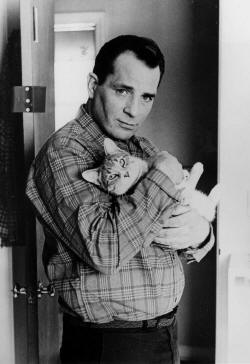 Jack Kerouac ([2][3]
born Jean-Louis Kérouac (though he called himself Jean-Louis Lebris
de Kérouac); March 12, 1922 – October 21, 1969) was an American novelist
and poet of French-Canadian descent.[4][5][6][7]
Jack Kerouac ([2][3]
born Jean-Louis Kérouac (though he called himself Jean-Louis Lebris
de Kérouac); March 12, 1922 – October 21, 1969) was an American novelist
and poet of French-Canadian descent.[4][5][6][7]Queer Places:
9 Lupine Rd, Lowell, MA 01850, Stati Uniti
34 Beaulieu St, Lowell, MA 01850, USA
Lowell High School, 50 Father Morissette Blvd, Lowell, MA 01852, Stati Uniti
Horace Mann School, 231 W 246th St, Bronx, NY 10471, Stati Uniti
The New School, 72 5th Ave, New York, NY 10011, Stati Uniti
Columbia University (Ivy League), 116th St and Broadway, New York, NY 10027
307 W 11th St, New York, NY 10014, Stati Uniti
454 W 20th St, New York, NY 10011, Stati Uniti
Hotel Chelsea, 222 W 23rd St, New York, NY 10011, Stati Uniti
San Remo Café, 93 Macdougal St, New York, NY 10012, Stati Uniti
Edson Cemetery, Lowell, Massachusetts 01852, Stati Uniti
 Jack Kerouac ([2][3]
born Jean-Louis Kérouac (though he called himself Jean-Louis Lebris
de Kérouac); March 12, 1922 – October 21, 1969) was an American novelist
and poet of French-Canadian descent.[4][5][6][7]
Jack Kerouac ([2][3]
born Jean-Louis Kérouac (though he called himself Jean-Louis Lebris
de Kérouac); March 12, 1922 – October 21, 1969) was an American novelist
and poet of French-Canadian descent.[4][5][6][7]
He is considered a literary iconoclast and, alongside William S. Burroughs and Allen Ginsberg, a pioneer of the Beat Generation.[8] Kerouac is recognized for his method of spontaneous prose. Thematically, his work covers topics such as Catholic spirituality, jazz, promiscuity, Buddhism, drugs, poverty, and travel. He became an underground celebrity and, with other beats, a progenitor of the hippie movement, although he remained antagonistic toward some of its politically radical elements.[9][10]
"You are ruining American poetry, O'Hara," a bellicose Jack Kerouac once shouted at him at a reading. Frank O'Hara instantly and witheringly returned fire: "That's more than you ever did for it, Kerouac."
Mexico City attracted international gay visitors between the 1940s and 1960s, with its cultural life, low cost of living, the intelligentsia’s leftist orientation, and the city’s architectural beauty. Political, cultural and sexual dissidents found the fast-growing city welcoming despite its rapid population growth: from 1.5 to 6 million between 1930 and 1960. Allen Ginsberg – who had regularly visited Mexico City from 1951 – reported its affordability to his friend Gary Snyder as well as his homosexual encountersduring a 1956 visit with Jack Kerouac and Peter Orlovsky. Some international visitors settled permanently. Foreign homosexuals found opportunities in couture and design, including milliner Henri de Châtillon, furniture designer Emmett Morley Webb and restaurateur and designer Jay de Laval. Earl Sennett, an instructor at Mexico City College in the 1940s and 1950s, directed the Mexico City Players, a theatrical troupe that included political dissidents like John T. Herrmann.
In 1969, at age 47, Kerouac died from an abdominal hemorrhage caused by a lifetime of heavy drinking. Since his death, Kerouac's literary prestige has grown, and several previously unseen works have been published. All of his books are in print today, including The Town and the City, On the Road, Doctor Sax, The Dharma Bums, Mexico City Blues, The Subterraneans, Desolation Angels, Visions of Cody, The Sea Is My Brother, and Big Sur.

Jack Kerouac, circa 1950
gelatin silver print
13 x 10 in. (33.02 x 25.4 cm.)
Stamped; twice with photographer's credit stamp on verso. Label with typed caption affixed to verso: "Jack Kerouac author of 'On the Road' and 'The Subterraneans'"
Printed circa 1950
Lot ID68518
.jpg)
Hotel Chelsea, New York City
454 W 20th St, New York, NY 10011
307 W 11th St
My published books: